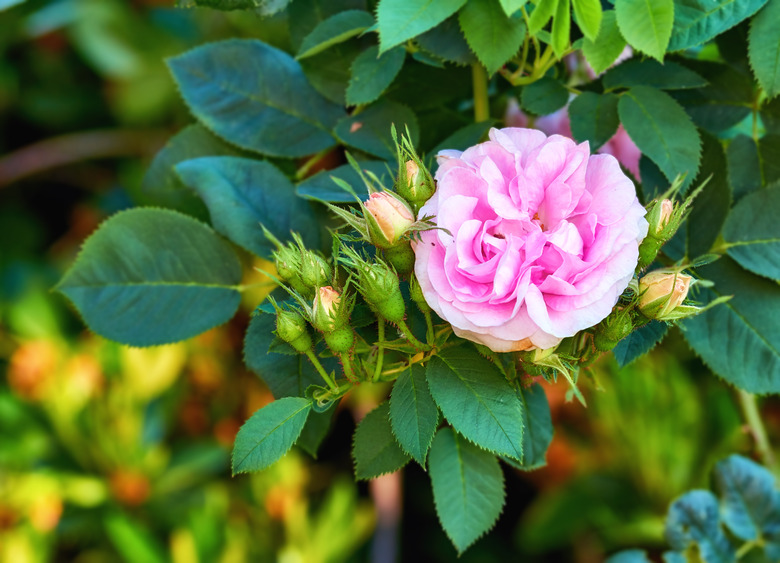What Are The White Spots On Rose Bushes?
We may receive a commission on purchases made from links.
White spots on rose bushes can turn your otherwise beautiful flowering shrubs into an unsightly spot in your garden. Roses (Rosa spp.) are among the most popular flower options to grow in a home garden, but they're susceptible to a host of disease and pest issues. These problems with roses range from annoying aesthetic issues to serious problems that can kill the rose bush. As soon as you notice white spots on rose bushes, look at the other symptoms to identify the cause and start treatment immediately.
Tip
White spots on rose bushes can indicate the presence of insects or diseases.
Powdery Mildew on Roses
Powdery Mildew on Roses
Powdery mildew often affects rose bushes. It can form at any time, but it's most common when the days are warm and dry and nights are cooler and humid. Roses growing in shady areas are particularly susceptible to powdery mildew. This disease often starts at the top of the plant and can spread through the wind.
This fungal disease forms a grayish-white powder that may look like spots of white. The powdery substance most often grows on the new growth, especially leaves, shoots and buds. It can also distort new leaves, causing some leaves to drop off the plant. Flower buds might not open, and powdery mildew can affect the quality of the roses that do open.
Handling Powdery Mildew
Handling Powdery Mildew
Prevention starts with the type of roses you choose. Some varieties are resistant to powdery mildew. If you spot powdery mildew taking hold, prune the rose bushes to remove the diseased parts.
Sanitize your pruning shears before making each cut to prevent spreading any disease pathogens to healthy parts of plants. Destroy the removed plant parts to keep the fungal disease from spreading. Applying fungicide to new growth, which is most susceptible, can also protect against powdery mildew.
Rose Leafhopper Pests
Rose Leafhopper Pests
Rose leafhoppers are insect pests that can cause white spots on roses. They feed on the roses, causing small white spots on upper leaf surfaces. Sometimes, the small white stippled areas take over and cause larger white spots on the leaves. On the bottom of the leaf, you might notice white cast skins left behind when these insects molt. Severe infestations can lead to brown leaves that fall off.
Handling Rose Leafhoppers
Handling Rose Leafhoppers
Small infestations might not cause much damage to your roses. If the rose leafhoppers are multiplying rapidly, apply insecticidal soap for a less-toxic way to treat the bugs without harming most beneficial insects. Spray the plant completely with the insecticidal soap. You might need to reapply the treatment weekly or biweekly to get rid of all the leafhoppers.
Anthracnose on Roses
Anthracnose on Roses
The fungal pathogen called Sphaceloma rosarum causes anthracnose, a disease that can cause white spots on your roses. It most often affects hybrid tea roses, old-fashioned climbing roses and rambler roses. You'll notice the spots on the leaves of your rose bushes, typically starting as red, brown or purple spots. The centers of those dots often turn gray or white with dark red or brown around the edges. Sometimes, the entire leaf turns yellow, withers and falls off the rose bush, and the canes can develop cankers.
Handling Anthracnose on Roses
Handling Anthracnose on Roses
Anthracnose thrives in cool, humid conditions. The disease can survive the winter in diseased plant tissue, so cleaning up your garden every year is important to stopping the spread of diseases. The spores can be carried by the wind or rain to new plant tissue, often entering through existing openings or damage on the plant.
Prune out any canes that show signs of anthracnose and destroy the debris. Sanitize the pruning equipment before making each cut to keep it from spreading. Fungicides that contain copper and sulfur may be effective in getting anthracnose under control in your rose garden.
You can reduce the risk of infection by keeping the rose plants healthy and strong. Prune them regularly to allow for good air circulation throughout the plant. Water rose bushes at the base to keep the leaves dry, which reduces the risk of fungal growth.
References
- The American Phytopathological Society: Diseases and Abiotic Disorders of Outdoor Roses
- Texas A&M AgriLife Extension: Rose Anthracnose
- Missouri Botanical Garden: Rose Problems
- University of Illinois Extension: Our Rose Garden – Disease and Insect Pests
- Missouri Botanical Garden: Hoppers and Leafhoppers
